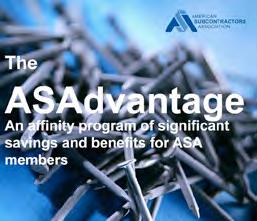
7 minute read
LEGALLY SPEAKING: Prompt Payment Laws: Know Your Rights
LEGALLY SPEAKING
Prompt Payment Laws: Know Your Rights
Advertisement
by Greg Reaume, McInerney & Dillon
You might find this article helpful if you have been in this situation: your company is three months into a project, but last month’s payment has not come through on time. When you ask the general about it, he says that you did not submit the right paperwork - even though you submitted the same type of paperwork that you previously had without any issues. You try to find more backup and resubmit your pay application but get the same response. In the meantime, your material suppliers have started to get angry and are threatening everything from stopping your credit line to putting a lien on the project. Almost a year later you find out that the general was just stalling and was not paying you because it had spent the money on another project it had blown the budget on.
Sounds stressful! And it is. Luckily, there are laws in most states penalizing general contractors for not paying you on time. These laws are generally called “prompt payment” laws. Some of them, like those in California, have a good amount of teeth. Their downside is that you usually have to start a lawsuit to kick them into gear. However, oftentimes just knowing enough to threaten using prompt payment laws can be just as good as starting a lawsuit.
A quick note - most of my practice is in California, so I will focus on the law there. The laws in other states are generally similar.
What Is a Prompt Payment Law?
A prompt payment law is a law that penalizes an owner for not paying a general contractor on time, or penalizes a general contractor not paying a subcontractor on time. These laws are found in the state’s legal code, usually called statutes.
In California, prompt payment laws are found in California Business and Professions Code (the “B&PC”) § 7108.5. Under that law, a general contractor has to pay a subcontractor fairly soon after receiving the corresponding payment from the project owner.
The only reason that a general contractor can withhold funds is if there is a “good faith dispute.” A good faith dispute is exactly what it sounds like. If your pay application asks for $50,000 in delivered materials but no one can find them on the project, then a general would be justified in withholding that money until the materials are found. However, anytime a general contractor withholds payment it can only withhold up to 150% of the disputed amount.
Similar laws apply to retention payments. Civil Code § 8814(a) is where you will find that law in case you are looking for some exciting Friday night reading.
These laws vary a bit between public
and private projects, but the overall idea is the same.
How Do Prompt Payment Laws Help Me Get Paid?
The first thing to realize is that prompt payment laws will not make money fall from the sky without threatening a lawsuit. I have yet to see a general contractor offer to pay penalties in addition to past due money purely out of a gust of goodwill.
In California, if a general contractor fails to pay a subcontractor within seven days after getting money from the project owner for a progress payment, then the general contractor: • may be disciplined by the California
State License Board, • forced to pay a penalty to the subcontractor of 2% of the amount outstanding for every month payment was not made, and • made to pay the subcontractor’s attorney’s fees for any action to collect the funds.
These penalties apply to both public and private projects and are in addition to other claims for damages that may apply.
A similar set of penalties applies to retention that has been wrongly withheld by a general contractor. The main difference is that a general contractor has ten days to pay retention after it has been paid, rather than the seven days for progress payments.
To sum up – prompt payment laws help you get paid the amount you are owed plus interest and the cost of your attorney’s fees when you have a legitimate claim to withheld funds, threaten (and possibly follow through with) a lawsuit.
Putting Knowledge to Use
Knowledge is power, but only if you use it. Prompt payment laws can help you get paid, but only if you set yourself up to take advantage of them. To do that, remember to:
Make sure that your payment applications actually reflect the amount of work done. If a general contractor can claim that there was a “good faith dispute,” then that may nullify your prompt payment claim. A simple example of a “good faith dispute” is where a subcontractor’s payment application asks for more money than it should. If it's not obvious that all of the money in a payment application is owed to you, then you might lose your right to go after prompt payment penalties.
When you sign a subcontract agreement, try to add in an exhibit that adds contract language stating that the prompt payment laws apply regardless of any other language in the contract. This is because the law may allow for a general contractor to put conditions of payment in the contract, and those conditions may nullify your ability to take advantage of prompt payment laws.
If you suspect there may be problems with payment, start putting the related documents - like invoices, payments, work logs, and emails – in a separate folder so you can easily send it to an attorney. If you can organize it well and summarize what happened in a timeline, that will save you attorney’s fees because it will take the attorney less time to try to reconstruct what happened.
All this said, future work from a general contractor you like working with is worth more money over the long run than chasing a small prompt payment claim. Prompt payment laws are great tools to have in your arsenal but something that should be used as a last resort.
Conclusion
Prompt payment laws help subcontractors get paid and encourage general contractors to behave like good businesspeople. Knowing how they work will help you structure your project documentation in a way that can help you use them if you need to. They are a good tool to have, but not a substitute for good working relationships over the long term.
About the Author
Greg Reaume is an attorney with the firm
McInerney & Dillon
in California. Mr. Reaume comes from a construction family and worked in the field before becoming a lawyer. He can be contacted at gwr@ mcinerney-dillon.com , 213.926.1516, or Instagram @the.construction.lawyer .
LEGAL BUDGET
Anyone working in construction should set aside a chunk of money for legal costs. Legal claims can come from many places. For example, a homeowner might sue on a warranty claim, or a general contractor might wrongly try to back-charge you. An employee might sue on a wage claim, or your insurance may wrongfully deny coverage. In any of those situations you are going to need to have a small war chest to set the record straight. A good attorney might be able to deal with most issues through phone calls and working informally with the other side. If not, they will be able to strategize with you about cutting your losses or continuing to argue for or against a claim against you. You should have at least $40,000 set aside in case you run into a serious legal problem. The costs to fight a case in court have a large range, but it is unlikely that you would spend less than $100,000 for a battle that went that far. That said – keep some money budgeted each year for “Legal.” Hopefully you will not need to use it, but if you do end up in a lawsuit you will find that budget to be a critical part of your firm’s long term viability.
A card that will work for you.
Simplify employee per diem with the Prepaid Expense Card. Easily load and unload funds as needed. Eliminate the hassle of cash and reimbursements. Take control of spending and limit payment risks.
A team you can count on.

Get support when you need it. Our dedicated relationship specialists will work with you throughout the life of your program.


Special pricing for ASA members







